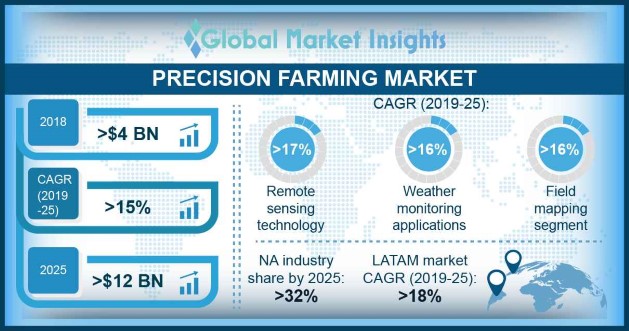Home > Agriculture > Agri Machinery & Tech > Agri Equipment > Precision Farming Market
Precision Farming Market Size
- Report ID: GMI227
- Published Date: Apr 2019
- Report Format: PDF
Precision Farming Market Size
Precision Farming Market size in 2018 was over USD 4 billion and is estimated to grow at around 15% CAGR from 2019 to 2025.
The precision farming practices are expected to witness a surge in the adoption as they enable farmers to accurately manage variations in the field, increase productivity, and reduce production costs. These practices help to gather relevant information by analyzing the real-time data about the conditions of the soil, crops, and local weather predictions and provide actionable insights to farmers with directions about the soil management, crop rotation, harvesting time, and optimal planting time. The precision farming technology is gaining popularity in the agriculture sector as it holds the potential to increase crop yield by using advanced IT-based agriculture methods.
| Report Attribute | Details |
|---|---|
| Base Year: | 2018 |
| Precision Farming Market Size in 2018: | 4 Billion (USD) |
| Forecast Period: | 2019 to 2025 |
| Forecast Period 2019 to 2025 CAGR: | 15% |
| 2025 Value Projection: | 12 Billion (USD) |
| Historical Data for: | 2014 to 2018 |
| No. of Pages: | 375 |
| Tables, Charts & Figures: | 443 |
| Segments covered: | Component, Technology, Application and Region |
| Growth Drivers: |
|
| Pitfalls & Challenges: |
|
Rapid use of the IoT in the agriculture sector is contributing to the growth of the precision farming market. Farm managers & producers are leveraging the capabilities of the IoT devices, such as sensors, GPS & GNSS systems, and automated steering systems, for soil sampling, temperature monitoring, filed mapping, irrigation management, and several other applications. These devices provide real-time insights on how to improve farming practices for greater efficiency. The growing uptake of drone technology for crop monitoring, identifying planting flaws, and pest & disease control & detection will also lead to the market growth. For instance, in May 2017, QuestUAV introduced DATAhawkAG all-round package for the precision agriculture mapping. When equipped with MicaSense RedEdge camera, the Q-100 DATAhawkAG helps to capture images in five discrete spectral bands and detect patterns co-related to plant stress and nutrient content.

